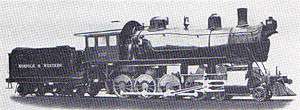N&W class M
N&W M class|

N&W #450, the very first M, in its 1906 Baldwin portrait. |
|
|
| Specifications |
|---|
| Configuration |
4-8-0 |
|---|
| Gauge |
4 ft 8 1⁄2 in (1,435 mm) |
|---|
| Leading dia. |
27 in (686 mm) |
|---|
| Driver dia. |
56 in (1,422 mm) |
|---|
| Length |
74 ft 11 3⁄4 in (22.85 m) |
|---|
| Height |
15 ft 5 in (4.70 m) |
|---|
| Adhesive weight |
160,000 lb (73 tonnes) |
|---|
| Loco weight |
200,000 lb (90.7 tonnes) |
|---|
| Fuel type |
Coal |
|---|
| Fuel capacity |
40,000 lb (18.1 tonnes) |
|---|
| Water cap |
12,000 US gal (45,000 l; 10,000 imp gal) |
|---|
| Boiler pressure |
200 lbf/in2 (1.38 MPa) |
|---|
| Heating surface |
2,940 sq ft (273.1 m2) |
|---|
| Cylinders |
Two |
|---|
| Cylinder size |
21 in × 30 in (533 mm × 762 mm) |
|---|
| Valve gear |
Stephenson (inside); Some later converted to Baker |
|---|
| Valve type |
12-inch (300 mm) piston valves |
|---|
|
|
|
|
|
N&W M1 class
| Type and origin |
|---|
|
Only differences from class M above are shown | | Power type |
Steam |
|---|
| Builder |
Baldwin (50),
ALCO-Richmond (50) |
|---|
| Build date |
1907 |
|---|
| Total produced |
100 |
|---|
|
|
|
|
|
N&W M2 class|

N&W #1138 in its Baldwin portrait. |
| Type and origin |
|---|
| Power type |
Steam |
|---|
| Builder |
Baldwin (50);
N&W Roanoke Shops (11) |
|---|
| Serial number |
Roanoke 182–192 |
|---|
| Build date |
1910 |
|---|
| Total produced |
61 |
|---|
|
|
|
|
|
|
|
The Norfolk and Western Railway's M, M1 and M2 classes (also known as the "Mastodon-class") were a series of 4-8-0 steam locomotives owned and operated by the Norfolk and Western Railway. These were the last significant deliveries of 4-8-0s in the United States. The N&W needed to get coal shipments over a mountain range, and powerful locomotives were needed. 4-8-0s were chosen over 2-8-2s because the 4-8-0 had better adhesive weight. Thus, in 1906, the first of the most numerous American class of 4-8-0 was contracted and built by Baldwin. The M1 class only differed from the M in valve gear. Because the M1's valve gear was poorly designed, there was excessive wear, making it impossible to keep them in alignment and valves properly set. Unsurprisingly, the M1's were the first to be retired which led to the M2 class engines with a better designed valve gear with less excessive wear.
Experiments
When bigger locomotives came to the N&W, some of the M's were used as switchers. But there was a problem: in some cities, smoke amount laws were broken, so the N&W decided to do an experiment with #1100 and #1112, both M2 types. First: they were both added with shorted flues and added with combustion chambers. They were also both added with a draft fan, driven by a steam turbine. Stokers and water level controls were added so the locomotives could be left alone for a long time. This gave both locos the name "Automatic Switcher". Mechanical lubrication was added so it was easier to maintain the parts that are hard to lubricate. Both of the engines tenders were modified to haul 20 tons of coal and 11,000 gallons of water. There were mechanical issues with this experiment however, so it didn't last very long. The draft fan would be occasionally damaged, because of the cinders. Ashes would also shoot out of the stack, so the crew was vulnerable to get covered. #1112 was added also with more heating surface, increasing the boiler pressure to 225 pounds. A cinder collector was added in front of the exhaust fan to collect cinders and bring them back to the firebox. But this experiment was still a big bust. Sadly, both #1100 and #1112 were retired in 1951, nearly ten years before the N&W gave up steam power in 1960.
Survivors
Several locomotives survive. The most well known is No. 475, part of the 1906 order, which is currently operating on the Strasburg Rail Road in Pennsylvania. No. 433, also of the 1906 order, is an outdoors static exhibit in a park Abingdon, Virginia, with a basic roof to protect it from rain. There are also two M2 locomotives, numbers 1118, 1134, and one M2c, 1151, which have resided in the Virginia Scrap Iron & Metal yard since 1950 until 2009. M2c #1151 was moved on 21 August 2009, M2 #1134 moved on 24 August, and M2 #1118 on 26 August. The 1134 has received cosmetic restoration and is now located at the Railroad Museum of Virginia, in Portsmouth Virginia. 1118 was traded for 0-6-0T no. 34 and will remain at NRHS chapter's 9th Street facility. 1151 was moved to the Virginia Museum of Transportation in Roanoke.
See also
References
- Carling, D. Rock (1972). 4-8-0 Tender Locomotives. Drake Publishers Inc. ISBN 087749-150-X.
- Rosenberg, Ron; Archer, Eric H. (1973). Norfolk & Western Steam (The Last 25 Years). New York, NY: Quadrant Press, Inc. pp. 11–16, 77–78. ISBN 0-915276-00-3.
- Jenkins, Richard. "The Lost Engines Of Roanoke".
- "Lost Engines of Roanoke". The Western Virginia Railroad Preservation Society. Archived from the original on February 16, 2012.
- "Photos of 1151's move".
- "Lost Train 1118 moved". RR Picture Archives.net.
- "Norfolk & Western 4-8-0 "Mastodon" Locomotives of the USA". Steamlocomotive.com. Archived from the original on April 3, 2016.
- "Engine No. 1134". Railroad Museum of Virginia.
- Hebert, Brian (September 22, 2002). "Experimental N&W steam question *PIC*". Railway Preservation News forums.

